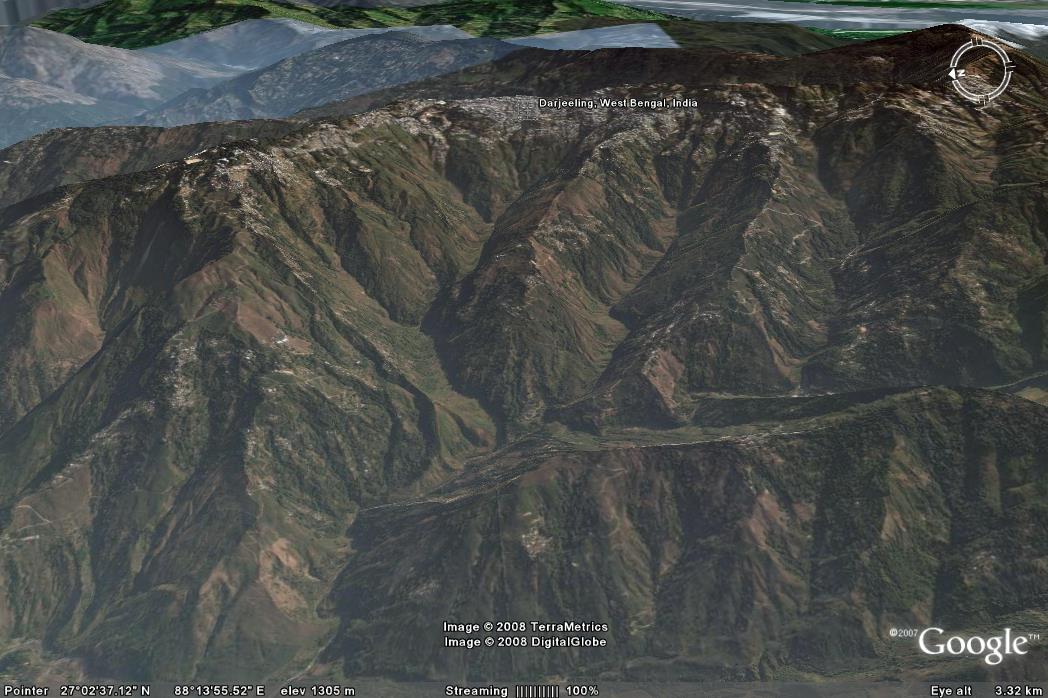16 June 2008
Landslides in Darjeeling, India
Posted by Dave Petley
In September 2007 intense monsoon rainfall in the Kalimpong region of Darjeeliing in Northern India triggered large numbers of landslides, killing at least seven people. This has brought to the fore the issue of environmental degradation and the consequent landslides in Himalayan environments. Darjeeling is a microcosm of problems arising throughout the Himalaya, with rapidly increasing numbers of landslides causing major problems.
Darjeeling is probably most famous for its tea plantations, which thrive there because of the rolling topography, moderate temperatures and high rainfall. These conditions are great for tea but bad for slope stability. Preservation of the landscape can minimise the occurrence of landslides, and indeed the tea plantations generally do this reasonably well if managed carefully. However, many Himalayan regions are currently facing a near perfect storm of conditions that promote landslides – rapid population growth (which means that there are more people needing more houses and more food), deforestation, uncontrolled building to low standards, intense monsoon rainfall, and the construction of low cost roads with poor engineering standards. The upshot is all too predictable – increasing numbers of landslides with a growing level of impacts. The image below from Google Earth shows the town of Kalimpong, located on a high ridge. The slopes below are scarred with active landslides, but more importantly much of the landscape is made up of old landslides and landslide scars. Kalimpong has been seriously affected by active landsliding in recent years.

Now, as the SW monsoon rains start to build, the issue of landslides in Darjeeling is becoming pressing once again. In Darjeeling though there is one glimmer of hope, which is a remarkable campaigning group called Save the Hills, led Wing Commander Praful Rao (Retired), who campaign to raise awareness of issues associated with slope instability in Darjeeling. They have a very detailed blog in which they document both the magnitude of the challenges and the range of their activities to reduce landslide occurrence and to increase preparedness and resilience. I thoroughly recommend taking a look as it represents a model of community-level action in response to landslide threats. The main blog is here:
http://savethehills.blogspot.com/
I particularly enjoyed their images of historic landslide events, which can be found here. Darjeeling is fortunate to have such an active group, and I hope that it is able to make a difference. Many other places would benefit hugely from the activities of such organisations.


 Dave Petley is the Vice-Chancellor of the University of Hull in the United Kingdom. His blog provides commentary and analysis of landslide events occurring worldwide, including the landslides themselves, latest research, and conferences and meetings.
Dave Petley is the Vice-Chancellor of the University of Hull in the United Kingdom. His blog provides commentary and analysis of landslide events occurring worldwide, including the landslides themselves, latest research, and conferences and meetings.
thank you güzel site muhabbet
Thanks ever so much, very useful article. If you do not mind, please visit my article related to pandeglang district in Banten, Indonesia at Kenali dan Kunjungi Objek Wisata di Pandeglang or Kenali dan Kunjungi Objek Wisata di Pandeglang second and also related to a leadership at Mengembalikan Jati Diri Bangsa and Oes Tsetnoc or Oes Tsetnoc the second and our hard work at Kerja Keras Adalah Energi Kita that's right Kerja Keras Adalah Energi Kita, and Gempa 6,4 SR Ujung Kulon Saat Kenali dan Kunjungi Objek Wisata di Pandeglang, very smart thank you!
Thanks for sharing such useful information in your article. If you do not mind, please visit my our hotel website.
Thanks for sharing such useful information in your article.